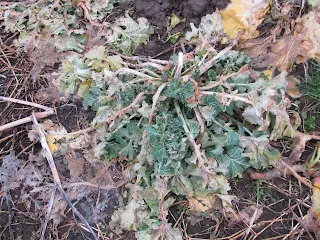 |
| Kale. |
If you are serious about being able to provide for yourself and your family out of a garden, you must give serious consideration to "The Hungry Gap". From Wikipedia
In cultivation of vegetables in a British-type climate, the hungry gap is the gardeners' name for the period in spring when there is little or no fresh produce available from a vegetable garden or allotment.
I walked around my garden this morning and snapped a few pictures. Clearly, there is not enough calories out there to sustain a family. But calories are usually what is easiest to come by. Grain is compact, stores and ship well and is easy to distribute. Starchy vegetables like potatoes store well. Vegetable oil is even more compact than grain.
The missing ingredient are green vegetables, nature's spring tonic.
 |
| A couple more photos of Kale. I had about 10% survival rate. |
 |
| Brussels Sprouts. This variety is Diablo. I had a "horse race" between Savoy Cabbage (Deadon) and Brussels Sprouts and the Savoy Cabbage won. The Brussels Sprouts were much more vulnerable to deer damage, had more waste and not as well liked by the family. |
 |
| Here is a head of Deadon cabbage that did not get picked. It is a total loss while one could still salvage some edible greens from the Diablo Brussels Sprouts. Our low for the winter was -3F which is about ten degrees warmer than usual. |
 |
| Shogoin Turnip. Turnips that hold their growing point closer to the ground seem to be more cold hardy than taller turnips. That is, round and "top" shaped turnips are preferable to tankard and spindle types. A corollary of this is that smaller (younger) plants are more winter hardy than big ones. Roots that are 2" in diameter or smaller seem to have no problem over-wintering here. |
 |
| Chickweed. This is a volunteer, that is, a weed. You can see dead kale plants scattered about the photo. |
 |
| Multiplier onions |
 |
| Wild garlic |
 |
| Wild onion, maybe Nodding onion. |
One of the nice things about most of these garden plants is that they can fend for themselves as semi-wild inhabitants of a feral garden. The two exceptions are the cabbage and Brussels Sprouts.
Kale and turnips are often included in wildlife food plot mixes.
The alliums (onions and their ilk) will happily fend for themselves given moist soil and light shade.










No comments:
Post a Comment
Readers who are willing to comment make this a better blog. Civil dialog is a valuable thing.